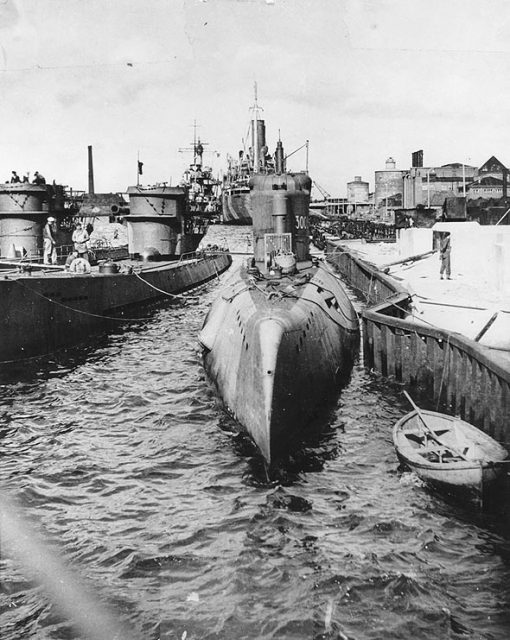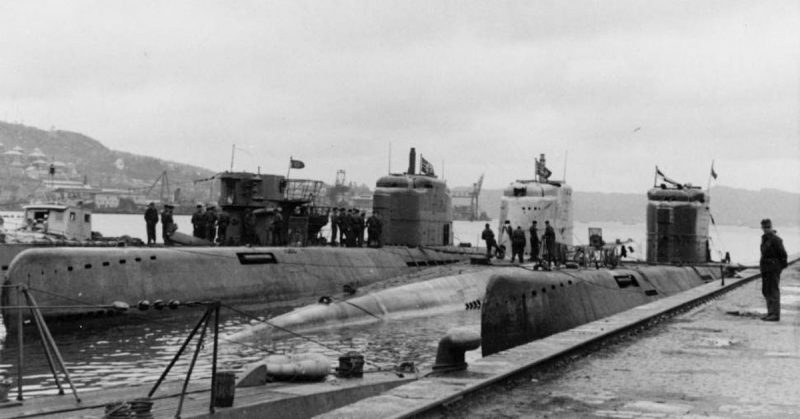One of the most technologically advanced submarines in the world attacked a British Royal Navy cruiser on May 4, 1945. The German U-boat U-2511 was a Type XXI-class “wonder” submarine.
Although highly advanced, the sub was one of the biggest failures of Nazi Germany.
It was over 250 feet long and displaced 1,620 tons. It carried six torpedo tubes that were reloaded with hydraulics and could fire more than 23 torpedoes stored on the vessel. Its greatest advancement, though, was the electric-driven engine that was able to go farther and faster than any other sub before it.
It could be considered the first modern undersea warship. The engine gave the U-boat the ability to operate underwater rather than on the surface. Other subs of the era spent most of their time on the surface, submerging only to attack or escape.
Fortunately for the crew of the British vessel on that day, the war had ended. Hitler killed himself on April 30. The U-2511 had just received notice of the ceasefire and, instead of attacking, they used the British ship for a practice run.
The German Navy, the Kriegsmarine, had relied on U-boats to win the war for the Third Reich but the U-2511 and its sister-ship, the U-3008, never fired a torpedo at a military target during WWII.
The XXI U-boat was such a colossal failure that Adam Tooze featured it in his book, “The Wages of Destruction: The Making and Breaking of the Nazi German Economy,” as an example of what not to do.
More recently, Marcus Jones wrote an article for the Naval War College Review. Jones, an associate professor at the US Naval Academy, called the submarine one of the primary examples of how Germany placed too much faith in technology to win victory in “complex and desperate situations.”
In 1943, Germany was determined to isolate Britain from its colonies. To do so, they turned to submarines. They intended to surround the British Isles with hundreds of them to prevent anything from coming in or going out by sea.
At first, the strategy worked. In October 1942, U-boats sank 56 ships in the area between Greenland and Iceland alone.

However, by 1943 the tide had changed. Advances in radar, anti-submarine planes and convoy tactics wreaked havoc on Germany’s Type VII subs.
The electric engines of those subs needed to be recharged by diesel which could only happen on the surface. It left them vulnerable and easily detected resulting in German subs being destroyed in vast numbers.
On top of that, the Type VII was slow. Allied convoys could often outrun them. If the Allies located a sub underwater, they could wait until it needed to surface. In May 1943, the Allies destroyed 43 U-boats representing a quarter of the entire operational fleet of German subs.
Hitler and his top military officials in the German Navy realized it was not feasible to try to improve on the existing submarine technology. They needed a new type of sub that would completely change the fundamentals of war at sea.
Helmuth Walter designed the new Type XXI U-boat with a figure-eight interior. It provided room for a significantly larger battery, so German U-boats rarely needed to surface to recharge their batteries.
The new design was also much faster. It could keep up with Allied convoys, traveling silently for 60 hours at 5 knots or upping the speed to 18 knots for 90 minutes. The old Type VII had never been able to go faster than 8 knots underwater for limited time spans.
The newer XXI also had many sensors and countermeasures to give it the advantage in battle.

Still, the ship was an utter failure.
First of all, they did not work as predicted. The hydraulic loading system for the torpedos took a long time before it operated correctly. The engines and steering systems did not work properly. All in all, the ships were not the threat the Kriegsmarine had envisaged.
But even if the U-boats had been working perfectly, they would most likely not have affected the war’s outcome. They were part of a losing strategy that plagued the German Navy.
WWII submarines were mainly used to guard the coast, harass enemy ships and intercept enemy convoys. It was what Type XXI was intended to do, albeit more efficiently.
Germany was already losing in all three areas.
Their coastline was under constant bombardment from Allied planes. The sheer volume of Allied convoys hopelessly outnumbered Nazi submarines – they would have needed hundreds of Type XXI subs to make a difference, and they only had two.
And German submarines could do nothing about the Allied ground forces closing in on their homeland.
Additionally, Jones estimates that the amount of steel put into the building of the two new subs cost the Germans 5,000 new tanks which could have prevented German losses on the Eastern Front.
Time after time, Germany turned to technologically advanced weapons that failed to deliver lasting victories while also neglecting their problems with the economy and political environment.
The more the Allies closed in on Berlin, the more the Germans accelerated the development of new weapons rather than increase the tried and true weapons already at their disposal.
Today, the Type XXI submarine serves as a lesson that technology is not the only factor in winning wars. In fact, slavishly pursuing new technology can put your side at a distinct disadvantage.
